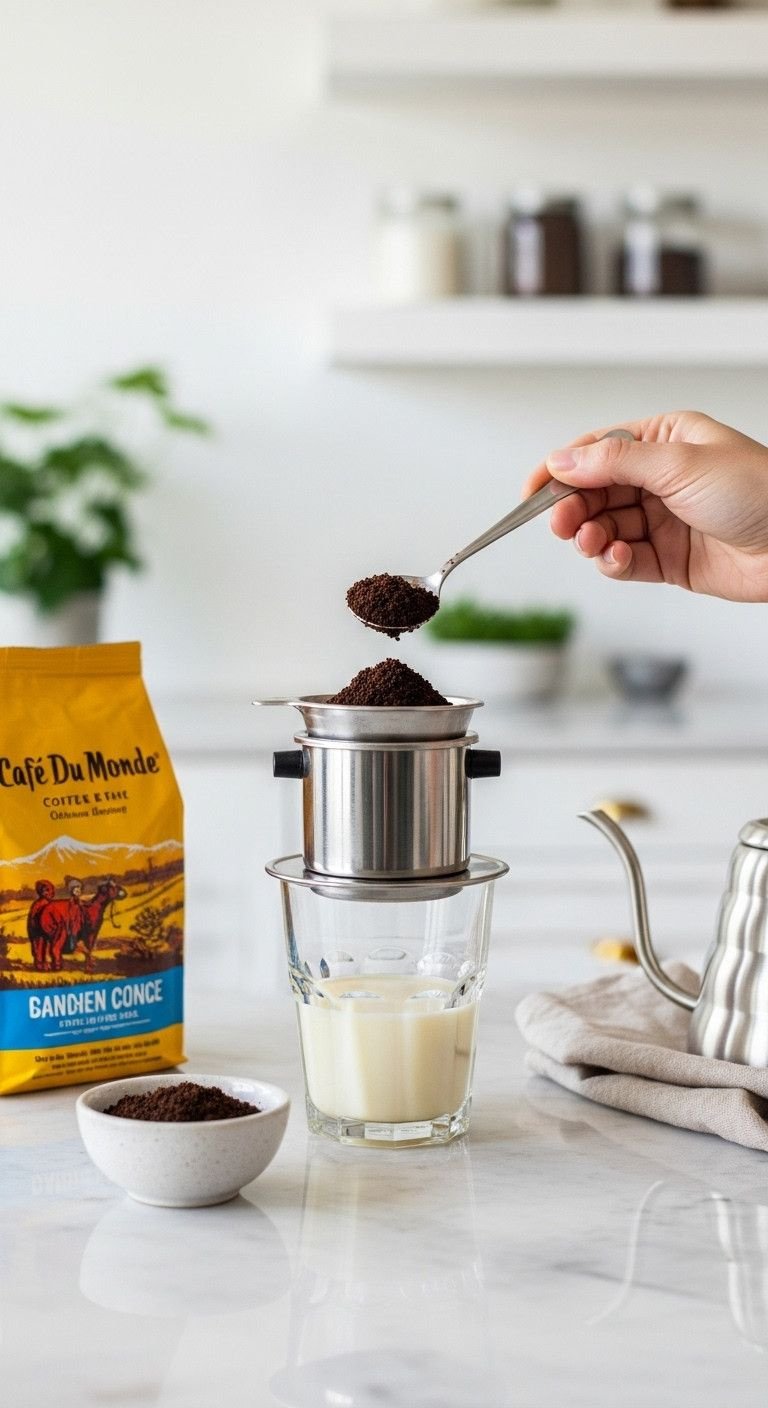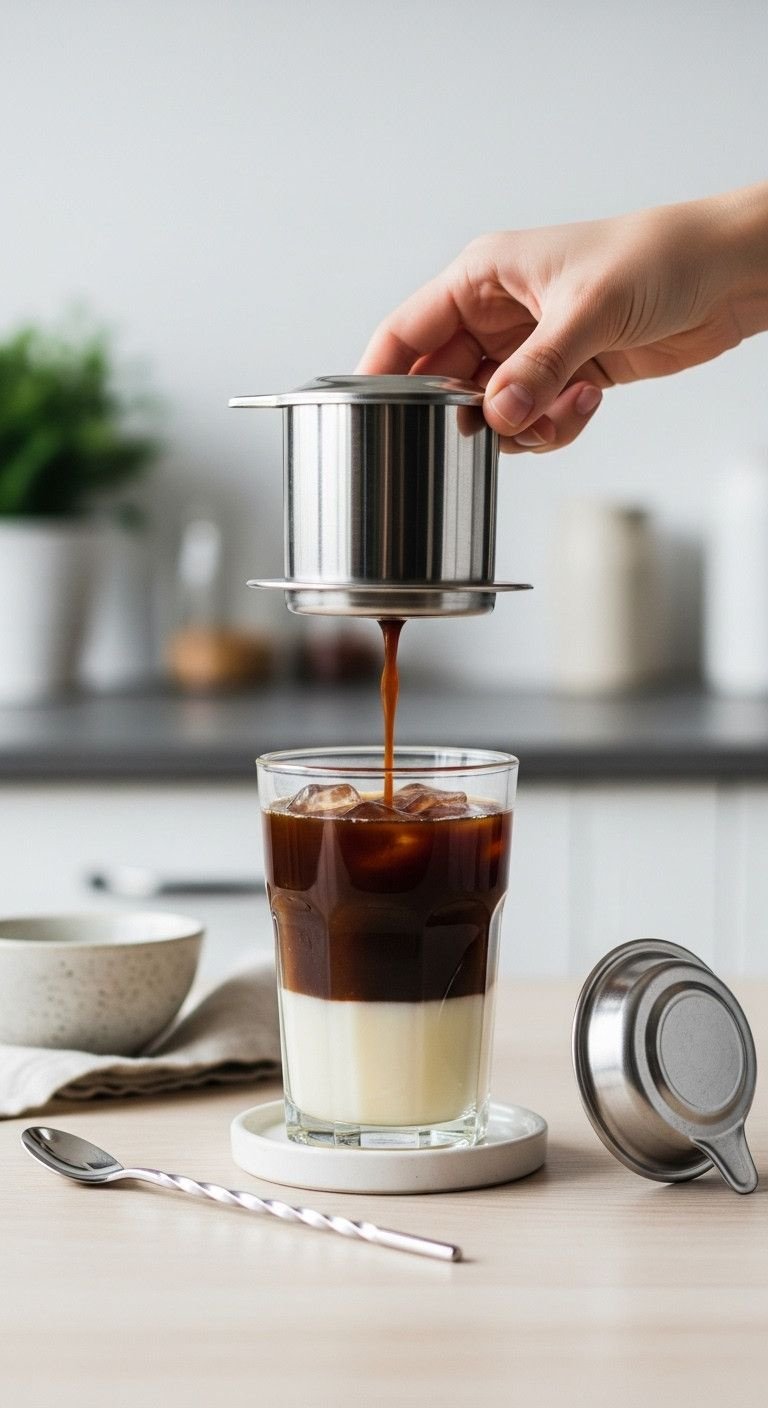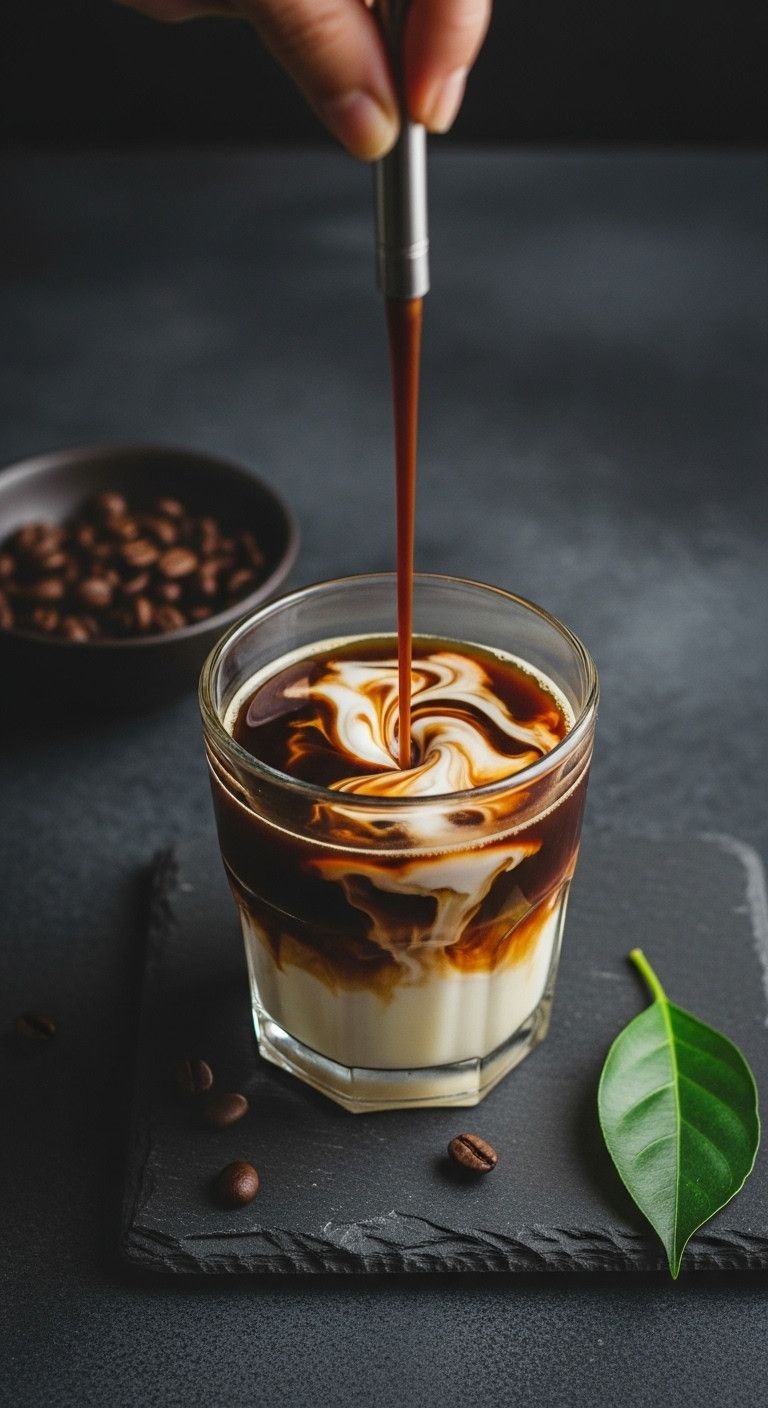As an Amazon Associate CoffeeXplore.com earns from qualifying purchases.
How To Make Perfect Vietnamese Iced Coffee The Authentic Way
Struggling to make that perfect café-style Vietnamese iced coffee at home? You’re not alone.
Vietnamese iced coffee, or Cà Phê Sữa Đá, is a uniquely strong and sweet drink made with a special slow-drip filter. The secret isn’t just dark coffee; it’s about the right tools and ingredients working together.
Authentic Vietnamese Iced Coffee, or Cà Phê Sữa Đá, is a uniquely strong and sweet beverage made by slow-dripping dark roast coffee through a ‘phin’ filter into a glass with sweetened condensed milk. This guide will show you the foolproof, authentic method. Get ready to master this delicious coffee ritual.
Craving the Perfect Vietnamese Iced Coffee? Here’s Why You Can’t Seem to Replicate It
That intense, creamy, and perfectly sweet coffee you love is more than just pouring espresso over ice. Many first attempts at a DIY Vietnamese coffee fall flat, tasting either weak, watery, or just not quite right. The reason is simple: authentic Cà Phê Sữa Đá relies on a specific combination of key elements that are often overlooked.
The magic comes from the interplay between the brewing method and the ingredients. It’s the bold, high-caffeine Robusta beans, the thick and caramelized sweetness of sweetened condensed milk, and the slow, patient brewing process of the Phin filter. This gravity press method creates a coffee concentrate so potent it can stand up to the intense sweetness of the milk and the dilution from the ice. Without these core components, you’re just making a different kind of iced coffee. This guide demystifies the process, guaranteeing you a perfect, café-quality result every single time.
The 3 Essential Keys to Authentic Vietnamese Iced Coffee
Before you start brewing, getting the right components is non-negotiable. The distinct flavor of Vietnamese iced coffee comes from three specific elements working in perfect harmony. Here’s exactly what you need and why each one is crucial for an authentic taste.
- The Coffee: Coarse Ground, Dark Roast Robusta Beans
The foundation of the drink is the coffee itself. Traditionally, this means using Robusta beans, which are bold, low in acidity, and high in caffeine. This strength is necessary to cut through the sweetness of the condensed milk. Brands like Café Du Monde (which contains chicory for an earthy flavor) or Trung Nguyen are classic choices. Most importantly, the grind must be coarse, like rough sea salt. A fine grind will clog the phin filter or pass through the holes, creating a bitter, muddy brew. -
The Milk: Full-Fat Sweetened Condensed Milk
This is not the place for regular milk and sugar. Sweetened condensed milk, like the popular Longevity brand, provides both the sweetness and the incredibly creamy, thick texture that defines the drink. It was historically used due to a lack of fresh milk refrigeration in Vietnam’s climate, and its caramelized, rich flavor has become the signature taste. Full-fat versions provide the best, most luxurious mouthfeel. -
The Tool: A Vietnamese Phin Filter
This small, stainless steel gravity press is the heart of the brewing process. The phin isn’t about speed; it’s about a slow, deliberate drip that extracts a huge amount of flavor into a small, powerful concentrate. A standard 4oz size is perfect for a single serving. Its simple, four-part design is easy to use and clean, and it’s the only way to achieve the traditional drip method.
How to Make Perfect Vietnamese Iced Coffee in 7 Simple Steps
This 7-step process is a relaxing, mindful ritual that anyone can master. We’ve tested this method repeatedly to ensure consistent, authentic results. Forget complicated techniques; this is the straightforward path to the perfect homemade Cà Phê Sữa Đá.
1. Prepare the Glass with Sweetened Condensed Milk

Save this foundational step to your ‘Coffee Recipes’ board!
Materials Needed:
- 2 tablespoons Sweetened Condensed Milk (full-fat gives the best creamy texture)
- 1 clear, heat-proof glass tumbler (approx. 10-12 oz)
Step-by-Step Directions:
- Pour the 2 tablespoons of sweetened condensed milk directly into the bottom of your glass.
- Optional: Place the glass in a shallow bowl of hot water to keep it warm. This helps the coffee and milk mix together more easily later on.
Pro-Tip: Taste is personal! 2 tablespoons is the classic ratio for a sweet, strong coffee. If you prefer it less sweet, start with 1.5 tablespoons. You can always add more later, but you can’t take it away.
2. Add Coffee Grounds to the Phin Filter

Pin this essential phin filter tip!
Materials Needed:
- 2 heaping tablespoons of coarse ground, dark roast coffee (like Café Du Monde or Trung Nguyen)
- 1 Vietnamese Phin Filter (with all parts: chamber, filter press, and lid)
Step-by-Step Directions:
- Place the phin filter chamber directly on top of your glass.
- Add the 2 heaping tablespoons of coffee grounds into the chamber.
- Gently shake the filter to level the grounds.
- Place the filter press (the small, perforated disc) inside the chamber on top of the grounds.
- Apply very light pressure to the press to evenly tamp the grounds. Do not press hard like you would for espresso.
Lesson Learned: The most common mistake is using a fine grind. It will either clog the filter entirely or pass through the holes, creating a muddy coffee. The grind should resemble coarse sea salt.
3. “Bloom” the Coffee Grounds

Save this expert coffee blooming technique!
Materials Needed:
- Hot water, just off the boil (about 200°F / 93°C)
- A kettle (a gooseneck kettle provides the best control)
Step-by-Step Directions:
- Boil water and let it sit for about 30-60 seconds to cool slightly. Using water that’s too hot can scorch the coffee, leading to a bitter taste.
- Slowly pour just enough hot water over the filter press to wet all the grounds (about 2 tablespoons).
- Wait for 30 seconds. You will see the coffee grounds expand or “bloom” as they release trapped gases. This step is crucial for an even and flavorful extraction.
Pro-Tip: Don’t skip the bloom! This single step makes a huge difference in the final taste, preventing a sour or weak brew. According to barista best practices, it’s the secret that separates good coffee from great coffee.
4. Fill the Phin and Start the Brew

Pin this guide to getting the perfect drip speed!
Materials Needed:
- Hot water (approx. 4 oz or 120ml)
- The lid for your phin filter
Step-by-Step Directions:
- After the 30-second bloom, slowly pour the hot water into the phin chamber, filling it to the top.
- Place the lid on the phin filter. This helps retain heat for better extraction.
- Watch it brew! The coffee should begin to drip slowly and steadily into the glass. The entire process should take about 4 to 5 minutes.
Troubleshooting Tip: If it drips too fast (under 3 mins), your grind is too coarse or you didn’t tamp enough. If it drips too slow (over 6 mins) or not at all, your grind is too fine or you tamped too hard. Adjust on your next brew!
5. Remove the Phin Filter

Save this clever, no-mess trick for your phin filter!
Materials Needed:
- The brewed coffee in your glass
- The phin filter lid
Step-by-Step Directions:
- Once the dripping has completely stopped, carefully lift the phin filter off the glass. It will be hot, so handle with care.
- Flip the phin filter’s lid upside down on your counter.
- Place the phin filter chamber directly onto the inverted lid. The lid now acts as a perfect little coaster to catch any remaining drips, keeping your counter clean.
Pro-Tip: To make cleanup easier later, immediately take the phin to the sink, discard the grounds (they’re great for compost!), and give it a quick rinse with hot water.
6. Stir Vigorously to Combine

Pin this crucial step for the perfect creamy texture!
Materials Needed:
- Your glass of hot coffee concentrate and condensed milk
- A long spoon
Step-by-Step Directions:
- Before adding any ice, use a long spoon to stir the coffee and condensed milk together vigorously.
- Scrape the bottom of the glass to ensure all the thick milk is incorporated.
- Continue stirring for about 20-30 seconds until the color is a uniform, creamy caramel-brown and the liquid is smooth.
Lesson Learned: You MUST do this step while the coffee is hot. If you add ice first, the condensed milk will get cold, seize up, and be nearly impossible to dissolve, leaving you with clumps at the bottom. At this stage, you have a hot Vietnamese coffee, or Cà Phê Sữa Nóng.
7. Fill with Ice and Serve Immediately

Save this refreshing final step to your ‘Summer Drinks’ board!
Materials Needed:
- Your mixed coffee
- A handful of ice cubes
- Optional: A second, larger glass
Step-by-Step Directions:
- Fill your serving glass completely with ice.
- Slowly pour the mixed, hot coffee over the ice. The hot coffee hitting the cold ice will chill it instantly.
- Give it one final, quick stir and enjoy immediately.
Pro-Tip: Use large, solid ice cubes. They melt much slower than crushed or small ice, which prevents your coffee from becoming watered down. Nobody wants a weak coffee!
Key Takeaways: Your Quick Guide to Perfect Cà Phê Sữa Đá
Here’s a quick cheat sheet to remember the most important steps for making authentic Vietnamese iced coffee every time.
- Coarse Grind is King: Always use a coarse grind (like for French press) to prevent clogging your phin filter.
- Don’t Skip the Bloom: Wetting the grounds for 30 seconds before brewing unlocks the best, most even flavor.
- Patience is a Virtue: A slow, 4-5 minute drip is the goal. Don’t rush the process; the slow drip builds the strong concentrate.
- Stir Hot, Then Add Ice: ALWAYS mix the hot coffee and condensed milk together before pouring over ice to ensure a smooth, creamy texture.
- Use Large Ice Cubes: Prevent a watery drink by using large ice cubes that melt slowly and keep your coffee potent.
FAQs About Vietnamese Cold Coffee Recipes
What is the best coffee to use for Vietnamese iced coffee?
The best and most traditional coffee is a dark roast, coarse ground Robusta blend. Brands like Café Du Monde (which contains chicory for an extra earthy depth) or Trung Nguyen are excellent, authentic choices. The bold, low-acidity flavor of Robusta beans is strong enough to stand up to the intense sweetness of the condensed milk.
Can I make Vietnamese iced coffee without a phin filter?
Yes, you can make a good approximation without a phin. The goal is to create a small, strong coffee concentrate. You can use a French press, AeroPress, or Moka pot to brew a double-strength coffee. Then, simply mix this concentrate with sweetened condensed milk and pour it over ice as usual.
Why is my Vietnamese coffee dripping too slow or too fast?
The drip speed is almost always determined by your coffee grind and tamping pressure. If it’s too slow or clogged, your grind is too fine or you pressed too hard. If it’s too fast and weak, your grind is too coarse or you didn’t tamp at all. Aim for a 4-5 minute total brew time for a balanced extraction.
Can I make a dairy-free or vegan Vietnamese iced coffee?
Absolutely! It’s very easy to make a delicious vegan version. Simply substitute the regular sweetened condensed milk with sweetened condensed coconut milk or sweetened condensed oat milk. Use the same 1:1 ratio. You can find these alternatives in most major grocery stores or online.
Final Thoughts
Making authentic Vietnamese iced coffee at home is far more than a simple recipe; it’s a rewarding ritual. The slow, patient drip from the phin filter and the final swirl that combines the dark coffee and sweet milk is an experience in itself. It’s a moment of calm that results in a uniquely delicious treat.
By understanding the relationship between the coarse Robusta grounds, the essential phin filter, and the creamy condensed milk, you’ve unlocked the secret to a perfect brew. You no longer need to rely on a café to satisfy your craving for that bold, sweet, and refreshing Cà Phê Sữa Đá.
Now that you have the authentic method, what’s the first thing you’ll do while you slowly sip your perfect homemade coffee?
Last update on 2025-12-05 / Affiliate links / Images from Amazon Product Advertising API

